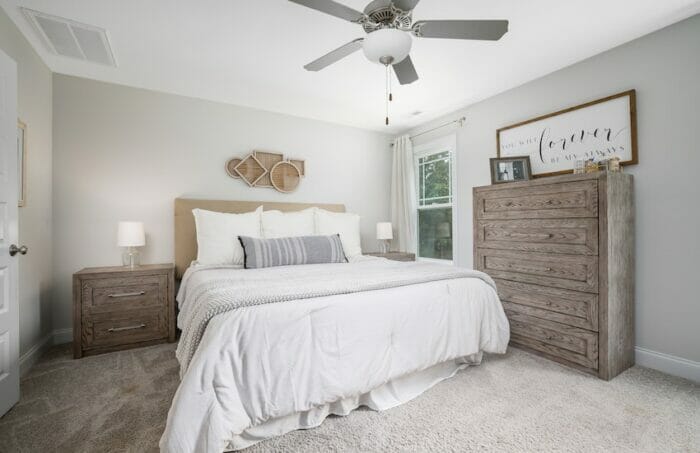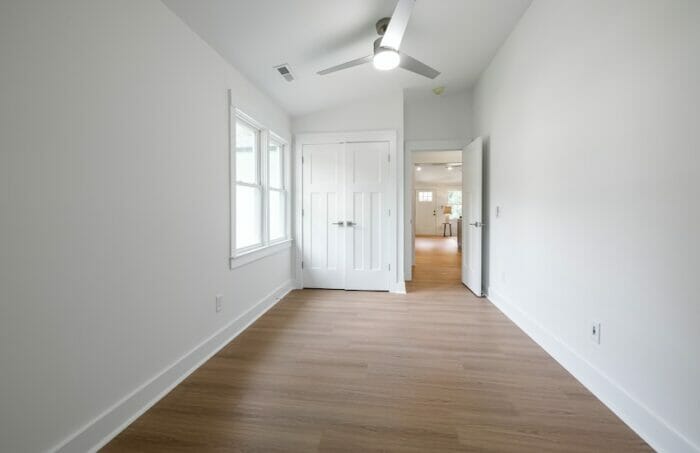When it comes to designing a tiny house, you have to be intentional about every single inch of space. Everything you put in a tiny home has to be smaller, and every bit of space has to be used – on the floors as well as on the walls.
 So, you probably can’t put in a ceiling fan, right? Actually, you can. Sure, a 42-inch fan like the one you have in your bedroom isn’t going to fit, and will overwhelm the space. But there are plenty of small ceiling fans available – some are as small as 18 inches and as powerful as larger fans.
So, you probably can’t put in a ceiling fan, right? Actually, you can. Sure, a 42-inch fan like the one you have in your bedroom isn’t going to fit, and will overwhelm the space. But there are plenty of small ceiling fans available – some are as small as 18 inches and as powerful as larger fans.
A Ceiling Fan Will Help Keep Your Tiny Home Comfortable
A ceiling fan is no substitute for an air conditioner – a lot of tiny homes can become sweltering in the summer without A/C. You need an air conditioner for your tiny house. But while cooling a tiny home with an air conditioner will be cheaper than cooling a full-size home, it still costs more the further down you turn the thermostat.
A ceiling fan can circulate air inside the space, and make it feel much cooler than it is. You can save some money on air conditioning without letting your space get stuffy. And if you’re aware of climate change issues in 2022, you might want to use as little air conditioning as possible to help the environment.

Measure Your Space Before Shopping for Fans
Before you go out shopping for ceiling fans to buy for your tiny home, you need to know how much space you actually have in your tiny home. Chances are you already know how much square footage you have to work with, especially if you built your tiny home yourself.
Fan sizes are determined by measuring the diameter of the circle created by the fan blades while they are in motion, also known as the “sweep.” In a regular house, you might buy a larger fan – 44 to 50 inches – for a room as large as the average tiny house, or about 225 square feet. However, a tiny home is not a room in a regular house. A tiny home crams your entire house into the space of just one largish room in a regular house. There’s a lot going on in a tiny home, and a 44-inch fan can easily overwhelm the space.
Consider the Height and Slope of Your Ceiling
If your tiny house has sloped ceilings, as many do, then a large fan probably won’t fit. You need to leave 18 inches of clearance between the blades and the wall or ceiling, so that the blades don’t make contact with the wall. Hanging a fan from a sloped ceiling usually means using a long downrod to lower the fan to a point where the blades can spin without hitting the ceiling.
However, you probably don’t want to use a long downrod in a tiny home. Your ceiling in a tiny house probably isn’t that high, unless you’re in a slightly larger tiny home like an accessory dwelling unit (ADU) or granny pod. If you hang a ceiling fan on a downrod from a low ceiling, it’s going to be too close to the floor to keep you cool, and also close enough that it presents a health hazard. A fan should be at least seven feet from the floor so no one is likely to hit their head on it.
That means flush mount ceiling fans are probably the best choice for tiny homes with low ceilings. Flush mount ceiling fans don’t have a downrod. They just hug the ceiling, so you can hang them with a little less vertical space available.
Of course, you want to look at ceiling fans with designs that will look good in your tiny home. Fans with just two or three blades tend to look best in a small, cluttered space – the fewer blades the fan has, the less space it appears to take up. Vertical blade ceiling fans are a good option for tiny homes with pitched ceilings. Cage ceiling fans are also small, unobtrusive, and powerful for cooling a tiny house.
Having a tiny house doesn’t mean having to forgo the cooling breeze from a ceiling fan on a warm summer’s night. There are plenty of ceiling fans that are the right size to hang in a tiny home. Choose a small fan with a powerful motor for all the cooling breezes you’ll ever need.
Want a modern home on a budget?
Subscribe and get this FREE GUIDE to learn the tips, tricks, and my best resources to create a family-friendly modern home on a budget!


